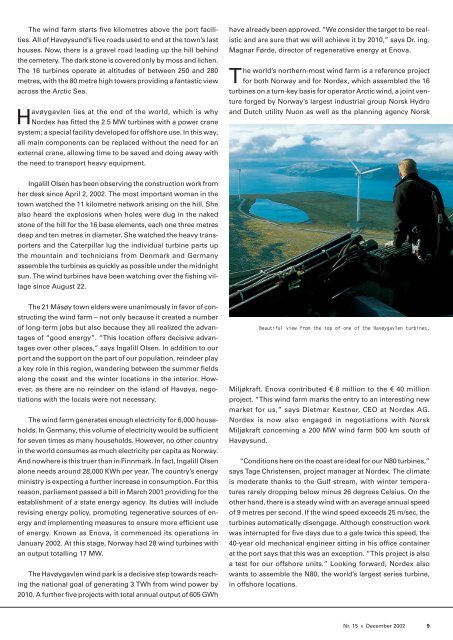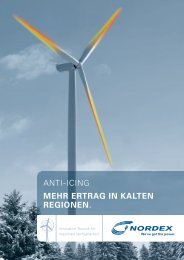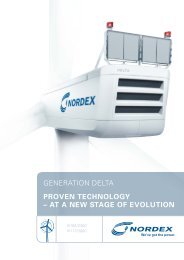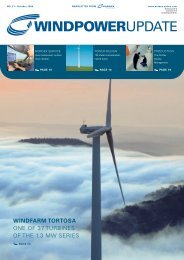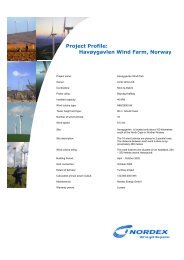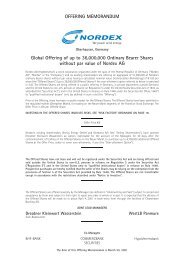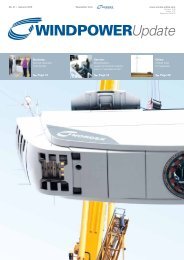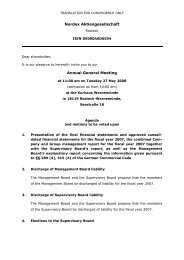Download WindpowerUpdate 15 - Nordex
Download WindpowerUpdate 15 - Nordex
Download WindpowerUpdate 15 - Nordex
Create successful ePaper yourself
Turn your PDF publications into a flip-book with our unique Google optimized e-Paper software.
The wind farm starts five kilometres above the port facilities.<br />
All of Havøysund’s five roads used to end at the town’s last<br />
houses. Now, there is a gravel road leading up the hill behind<br />
the cemetery. The dark stone is covered only by moss and lichen.<br />
The 16 turbines operate at altitudes of between 250 and 280<br />
metres, with the 80 metre high towers providing a fantastic view<br />
across the Arctic Sea.<br />
Havøygavlen lies at the end of the world, which is why<br />
<strong>Nordex</strong> has fitted the 2.5 MW turbines with a power crane<br />
system; a special facility developed for offshore use. In this way,<br />
all main components can be replaced without the need for an<br />
external crane, allowing time to be saved and doing away with<br />
the need to transport heavy equipment.<br />
Ingalill Olsen has been observing the construction work from<br />
her desk since April 2, 2002. The most important woman in the<br />
town watched the 11 kilometre network arising on the hill. She<br />
also heard the explosions when holes were dug in the naked<br />
stone of the hill for the 16 base elements, each one three metres<br />
deep and ten metres in diameter. She watched the heavy transporters<br />
and the Caterpillar lug the individual turbine parts up<br />
the mountain and technicians from Denmark and Germany<br />
assemble the turbines as quickly as possible under the midnight<br />
sun. The wind turbines have been watching over the fishing village<br />
since August 22.<br />
The 21 Måsøy town elders were unanimously in favor of constructing<br />
the wind farm – not only because it created a number<br />
of long-term jobs but also because they all realized the advantages<br />
of “good energy”. “This location offers decisive advantages<br />
over other places,” says Ingalill Olsen. In addition to our<br />
port and the support on the part of our population, reindeer play<br />
a key role in this region, wandering between the summer fields<br />
along the coast and the winter locations in the interior. However,<br />
as there are no reindeer on the island of Havøya, negotiations<br />
with the locals were not necessary.<br />
The wind farm generates enough electricity for 6,000 households.<br />
In Germany, this volume of electricity would be sufficient<br />
for seven times as many households. However, no other country<br />
in the world consumes as much electricity per capita as Norway.<br />
And nowhere is this truer than in Finnmark. In fact, Ingalill Olsen<br />
alone needs around 28,000 KWh per year. The country’s energy<br />
ministry is expecting a further increase in consumption. For this<br />
reason, parliament passed a bill in March 2001 providing for the<br />
establishment of a state energy agency. Its duties will include<br />
revising energy policy, promoting regenerative sources of energy<br />
and implementing measures to ensure more efficient use<br />
of energy. Known as Enova, it commenced its operations in<br />
January 2002. At this stage, Norway had 28 wind turbines with<br />
an output totalling 17 MW.<br />
The Havøygavlen wind park is a decisive step towards reaching<br />
the national goal of generating 3 TWh from wind power by<br />
2010. A further five projects with total annual output of 605 GWh<br />
have already been approved. “We consider the target to be realistic<br />
and are sure that we will achieve it by 2010,” says Dr. ing.<br />
Magnar Førde, director of regenerative energy at Enova.<br />
The world’s northern-most wind farm is a reference project<br />
for both Norway and for <strong>Nordex</strong>, which assembled the 16<br />
turbines on a turn-key basis for operator Arctic wind, a joint venture<br />
forged by Norway’s largest industrial group Norsk Hydro<br />
and Dutch utility Nuon as well as the planning agency Norsk<br />
Beautiful view from the top of one of the Havøygavlen turbines.<br />
Miljøkraft. Enova contributed 3 8 million to the 3 40 million<br />
project. “This wind farm marks the entry to an interesting new<br />
market for us,” says Dietmar Kestner, CEO at <strong>Nordex</strong> AG.<br />
<strong>Nordex</strong> is now also engaged in negotiations with Norsk<br />
Miljøkraft concerning a 200 MW wind farm 500 km south of<br />
Havøysund.<br />
“Conditions here on the coast are ideal for our N80 turbines,”<br />
says Tage Christensen, project manager at <strong>Nordex</strong>. The climate<br />
is moderate thanks to the Gulf stream, with winter temperatures<br />
rarely dropping below minus 26 degrees Celsius. On the<br />
other hand, there is a steady wind with an average annual speed<br />
of 9 metres per second. If the wind speed exceeds 25 m/sec, the<br />
turbines automatically disengage. Although construction work<br />
was interrupted for five days due to a gale twice this speed, the<br />
40-year old mechanical engineer sitting in his office container<br />
at the port says that this was an exception. “This project is also<br />
a test for our offshore units.” Looking forward, <strong>Nordex</strong> also<br />
wants to assemble the N80, the world’s largest series turbine,<br />
in offshore locations.<br />
Nr. <strong>15</strong> ı December 2002 9


